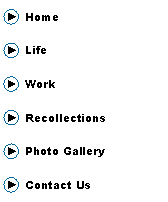|
Remembering M.S.S.R |
|
A Unique Craftsman |

Approach to WorkAs a professionalHe was an excellent Teacher and a very good learner through his gift for listening. He was keen to spread the knowledge and equally keen to gather more knowledge. From the days of “Autocode” – the tool used at the beginning of his career, he was learning “dotNet and C#” during his last days to teach a group of young professionals. Whether it was private coaching to an individual (or) a class, again the audience received the special care and attention. He would not stop until he felt satisfied that the knowledge had been successfully communicated. He was an excellent Orator - whether it was a lecture for ½ hour (or) 3 hours, the audience enjoyed it with same interest. He believed in communication, at all levels. The Customers were never kept at dark about the progress of the work. They received prompt and accurate information about the planning progress and execution of the work. He insisted that his colleagues followed it in all aspects – not only in the progress of the work, but even in small things. Being in the fast changing “Information Technology” field, he used to buy lot of books, magazines to learn new things. When Internet was introduced he used it in all possible ways to learn about whatever technology that he was using at that time. He was completely against piracy of all kinds. In India, where it is an accepted norm to have pirated software come preloaded on the hardware, he firmly believed in using legal copies of Software and insisted that all his clients do the same too. When the Technology changes from one area to next – like different development languages, databases, operating systems and so on, he was one of the very few first people to adapt to the new Technology. When Clipper ( a Compiler for dBase like tools) was not even available in India, he imported it and made his development Team to use it. He was the first person to buy “Delphi” the Windows based development Tool from Borland. The company that was in charge of marketing & sales of “Delphi” in India asked him to train all it’s Delphi Customers. Same thing happened again when new versions of operating systems were released in India. Approach to System ArchitectureSri. M.S.S.Ramanujan designed many Software Applications for different business areas. In all these applications, he followed some basic rules. They are: · Simple design · Stability · Ease of operation · Flexible for future expansion
First, he would study the Business procedure rather than studying the system requirement. He did it this way, as he felt that understanding the business is the key to design better Software. Then he would study the manual operation that is taking place at the moment. He would always have good suggestions to improve the manual procedure. These improvements would simplify the operation and help the management. Though this is not part of the System development assignment, he was happy to do this to many organisations. In addition to the Management, the operations team would gladly accept these improvements. Only after this, he would start the system study. In this exercise, he would discuss with all the people concerned (he would call them “Players of the System”) about the requirement. After the system requirement, he would present his understanding to the management as well as to the end users. He would always carry with him the “Players of the System” to ensure that he gets the full co-operation from them. He felt that, even if one of them is not interested then Software implementation won’t succeed. The focus in the system design would be to help the users in their operations as well as help the management to get the desired information. When developing the systems, he would follow an iterative and incremental strategy to deliver the software in phases. He believed that this allowed · Transparency of progress in development to the Management · The ability to accommodate design changes fairly easily · Allow the users to get familiar with the software · Allow the users to start using the software to perform the basic requirements very quickly. As you can see, this is agile development methodology in implementation before the term was coined In the development of the system, he largely believed in Code Generators for routine tasks. This way, the application would have proven code, no mistakes and reduces time in testing. He practiced this approach not only in the systems developed by his team, but also in the organisations where he guided the development team. He strongly believed in strict validations on the input data. He would say ‘Do not allow the user to make a mistake in using your system. If you give room to make a mistake in your system, then there is no point in blaming the user that he/she had done a mistake’. He used to give more importance to the functionality, ease of use and stability of the system than to the user interface. He felt that the user should first feel confident in using the system, it should provide him the required benefits, the cosmetics can always be added later, if required. This doesn’t mean that the user interfaces would be poor in his designs. They would be simple to view and easy to use. He would think about the complete system cycle in all the Software developments that he was guiding – like correct data capture, information generation, regular and automatic backup of the data, alerting the user and management if something goes wrong and future expansion that could be added to the system. It would be very good experience to anyone who is listening to him when he explained these concepts. He would say ‘like any system in nature is complete, our systems should be complete in all aspects’.
He must be one of the very few Software professionals in India who worked from the punch card days to dotNet development. He was never tired of learning a new platform, new development tools, redesigning the same systems in the latest platforms. When working on a new Tool, he would feel very happy like a child. And he would make his colleagues and students feel comfortable in learning the new tool. He was much ahead of his times in using many novel ideas in the system development. When only flat files were used and sequential access was the only method used by many people at that time, he was using Index and Sub Index files for faster data access. He took it as a challenge to develop the systems with whatever limited hardware resources that was made available to him. He would never complain that the given hardware is not sufficient. Here is a snapshot of the platforms that MSSR worked with, keeping in mind that he played with a lot more than what the final products were developed in.
|


|
Programming Languages |
Operating Systems |
Database Platforms |
Hardware platforms |
|
Autocode |
Main frame Operating Systems |
dBase & FoxBase |
IBM Main Frames |
|
Assembly |
Mini computers Operating Systems |
Paradox |
Mini Computers |
|
BASIC |
CP/M |
Access |
8086 based Systems |
|
COBOL |
MS DOS, PC DOS & OS 2 |
Oracle |
PCs with 8086, 286, 386, 486 and Pentium processors |
|
Fortran |
Windows 3.1 to Windows 2000 |
SQL Server |
|
|
Pascal |
Unix |
|
|
|
dBase |
Linux |
|
|
|
Clipper |
|
|
|
|
FoxBase |
|
|
|
|
FoxPro |
|
|
|
|
Paradox |
|
|
|
|
Delphi |
|
|
|
|
C# |
|
|
|